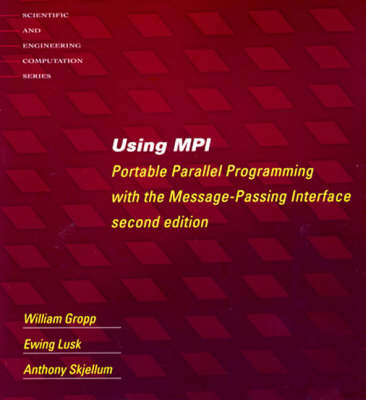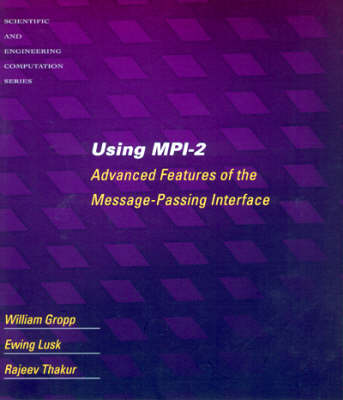Scientific and Engineering Computation
5 total works
The Message Passing Interface (MPI) specification is widely used for solving significant scientific and engineering problems on parallel computers. There exist more than a dozen implementations on computer platforms ranging from IBM SP-2 supercomputers to clusters of PCs running Windows NT or Linux ("Beowulf" machines). The initial MPI Standard document, MPI-1, was recently updated by the MPI Forum. The new version, MPI-2, contains both significant enhancements to the existing MPI core and new features.Using MPI is a completely up-to-date version of the authors' 1994 introduction to the core functions of MPI. It adds material on the new C++ and Fortran 90 bindings for MPI throughout the book. It contains greater discussion of datatype extents, the most frequently misunderstood feature of MPI-1, as well as material on the new extensions to basic MPI functionality added by the MPI-2 Forum in the area of MPI datatypes and collective operations. Using MPI-2 covers the new extensions to basic MPI. These include parallel I/O, remote memory access operations, and dynamic process management. The volume also includes material on tuning MPI applications for high performance on modern MPI implementations.
MPI - The Complete Reference
by William Gropp, Steven Huss-Lederman, Andrew Lumsdaine, Ewing Lusk, Bill Nitzberg, William Saphir, and Marc Snir
Using MPI and Using MPI-2
by William Gropp, Ewing Lusk, Anthony Skjellum, and Rajeev Thakur
The Message Passing Interface (MPI) specification is widely used for solving significant scientific and engineering problems on parallel computers. There exist more than a dozen implementations on computer platforms ranging from IBM SP-2 supercomputers to clusters of PCs running Windows NT or Linux ("Beowulf" machines). The initial MPI Standard document, MPI-1, was recently updated by the MPI Forum. The new version, MPI-2, contains both significant enhancements to the existing MPI core and new features.Using MPI is a completely up-to-date version of the authors' 1994 introduction to the core functions of MPI. It adds material on the new C++ and Fortran 90 bindings for MPI throughout the book. It contains greater discussion of datatype extents, the most frequently misunderstood feature of MPI-1, as well as material on the new extensions to basic MPI functionality added by the MPI-2 Forum in the area of MPI datatypes and collective operations. Using MPI-2 covers the new extensions to basic MPI. These include parallel I/O, remote memory access operations, and dynamic process management. The volume also includes material on tuning MPI applications for high performance on modern MPI implementations. This two-volume set contains Using MPI and Using MPI-2.
Using Advanced MPI
by William Gropp, Torsten Hoefler, Rajeev Thakur, and Ewing Lusk
This book offers a practical guide to the advanced features of the MPI (Message-Passing Interface) standard library for writing programs for parallel computers. It covers new features added in MPI-3, the latest version of the MPI standard, and updates from MPI-2. Like its companion volume, Using MPI, the book takes an informal, example-driven, tutorial approach. The material in each chapter is organized according to the complexity of the programs used as examples, starting with the simplest example and moving to more complex ones.
Using Advanced MPI covers major changes in MPI-3, including changes to remote memory access and one-sided communication that simplify semantics and enable better performance on modern hardware; new features such as nonblocking and neighborhood collectives for greater scalability on large systems; and minor updates to parallel I/O and dynamic processes. It also covers support for hybrid shared-memory/message-passing programming; MPI_Message, which aids in certain types of multithreaded programming; features that handle very large data; an interface that allows the programmer and the developer to access performance data; and a new binding of MPI to Fortran.
The Message Passing Interface (MPI) specification is widely used for solving significant scientific and engineering problems on parallel computers. There exist more than a dozen implementations on computer platforms ranging from IBM SP-2 supercomputers to clusters of PCs running Windows NT or Linux ("Beowulf" machines). The initial MPI Standard document, MPI-1, was recently updated by the MPI Forum. The new version, MPI-2, contains both significant enhancements to the existing MPI core and new features.Using MPI is a completely up-to-date version of the authors' 1994 introduction to the core functions of MPI. It adds material on the new C++ and Fortran 90 bindings for MPI throughout the book. It contains greater discussion of datatype extents, the most frequently misunderstood feature of MPI-1, as well as material on the new extensions to basic MPI functionality added by the MPI-2 Forum in the area of MPI datatypes and collective operations.Using MPI-2 covers the new extensions to basic MPI. These include parallel I/O, remote memory access operations, and dynamic process management. The volume also includes material on tuning MPI applications for high performance on modern MPI implementations.




